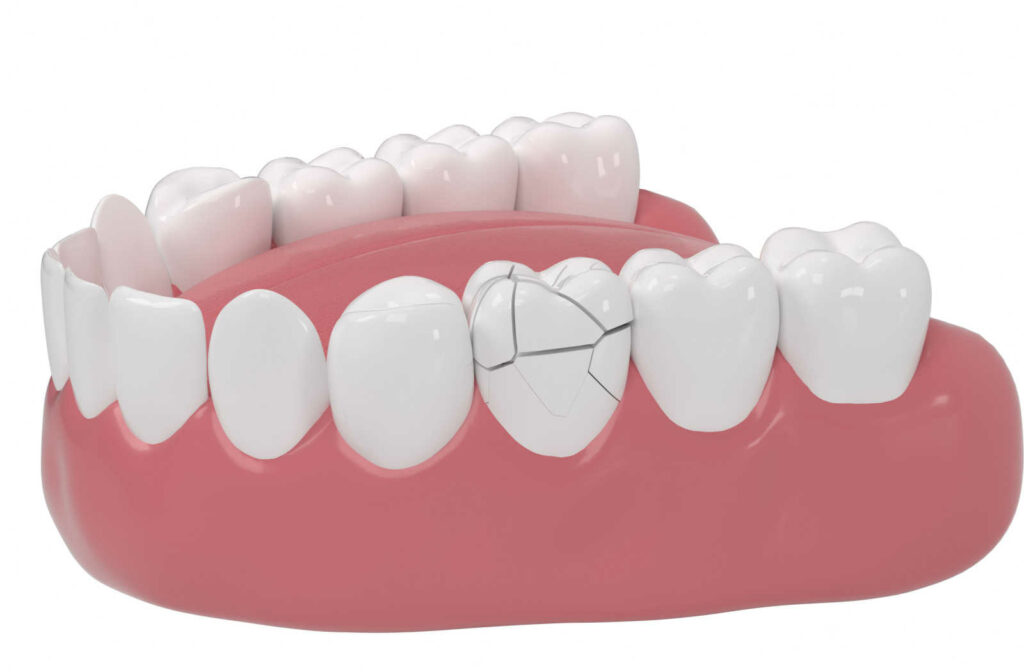A cracked tooth can happen to anyone regardless of age, lifestyle, or health. Cracks can appear in a variety of ways, and the severity of any crack falls on a spectrum.
You may not experience all the signs of a cracked tooth, and sometimes no symptoms appear. Pain that comes and goes is the most common indication of a cracked tooth. If you experience pain that feels like a cracked tooth, schedule an appointment with your dentist. Your dentist can help diagnose the root of the problem and fix the damage.
What Can Cause a Cracked Tooth?
A cracked tooth, often referred to as cracked tooth syndrome (CTS), can occur from several causes, including:
- Biting down too hard on food such as hard candy or popcorn kernels
- Chewing on ice or gum
- Excessive tooth grinding
- Physical trauma or injury from sports, a fall, or other accidents
- Weakened tooth integrity from large fillings or root canals
As you age, you have a higher risk of cracking a tooth. The majority of cracked tooth cases are found in patients who are over 40.

What Are the Different Types of Cracks in Your Tooth?
Your teeth contain two parts: the crown, the visible part of the tooth, and the root below your gums. Both the crown and the root are layered, consisting of:
- Enamel: the hard outer surface
- Dentin: the mid layer of the tooth
- Pulp: the soft tissue of nerves and blood vessels
Tooth cracks can affect any or all of these layers. The severity of the crack is determined by the crack type and where the crack is located.
Cracks can appear in several different forms:
- Craze lines: small cracks in the enamel, typically causing no pain
- Fractured cusps: typically occur around the dental fillings and don’t impact the pulp of the tooth, so they only cause minor pain
- Split tooth: a split that travels below the surface of the gum line and sometimes can be separated into two segments, making it difficult for a dentist to save the tooth
- Vertical root fractures: cracks that begin just below the gum line and move to the tooth’s surface, which may not cause symptoms
How Can Dentists Diagnose a Cracked Tooth?
When your dentist evaluates your teeth for cracks or fractures, they’ll inspect your teeth visually or may pass light through to illuminate the fracture. They may also put a staining dye on your teeth to highlight the crack or use advanced imaging technology to search the hard-to-reach areas of the mouth.
What Are the Symptoms of a Cracked Tooth?
Not all cracked teeth will cause symptoms, and people sometimes have cracked teeth without knowing. While some cracks are mild and don’t need treatment, some can become infections if ignored.
You should seek dental care if you experience symptoms such as:
- Sensitivity to hot and cold
- Intermittent pain
- Pain when chewing, biting, or clenching your jaw
- Swelling around the cracked tooth and gum irritation
- Sensitivity to sugar and sweetness
Untreated cracks in your teeth can grow, spread, and become infected, so it’s important to seek treatment if your tooth sensitivity or pain is affecting your life.
How Is a Cracked Tooth Treated?
Your dentist can recommend a treatment plan to maintain optimal oral health depending on the type of crack, its severity, your symptoms, and where it’s located.
Bonding
In a bonding procedure, your dentist uses resin to fill the crack or fracture. It’s an immediate solution that looks natural, but it’s not suited for all teeth. For teeth with less direct biting or chewing, bonding is an effective option.
Crown
A crown is an individually fitted dental prosthetic, typically composed of porcelain or ceramic, which fits over the cracked tooth as a cap. It’s now possible to get same-day CEREC crowns in a single appointment.
If you don’t want to wait weeks for a crown mould to be sent to and from an external lab, CEREC crowns are a time-saving solution. Since it’s a same-day appointment, you don’t need to wear an uncomfortable temporary crown while you wait, and every part of the process is done in the clinic.
Root Canal
If the pulp or root damage is too extensive, your dentist may recommend a root canal. This procedure can remove the damaged interior layer to prevent infection and restore some integrity to the tooth.
Tooth Extraction
In the most severe cases, where the tooth’s surface, nerves, and roots are beyond repair, extraction may be your best option. If you’re worried about the look of missing a tooth, a dental implant can help restore the appearance of your teeth.
Keep Your Smile at Its Best
With personalized dentistry, our team helps keep your mouth healthy and your smile glowing. Whether you’re coming in for your comprehensive cleaning or have concerns about your teeth or health, see us at Palermo Village Dental for experienced, customized care.




